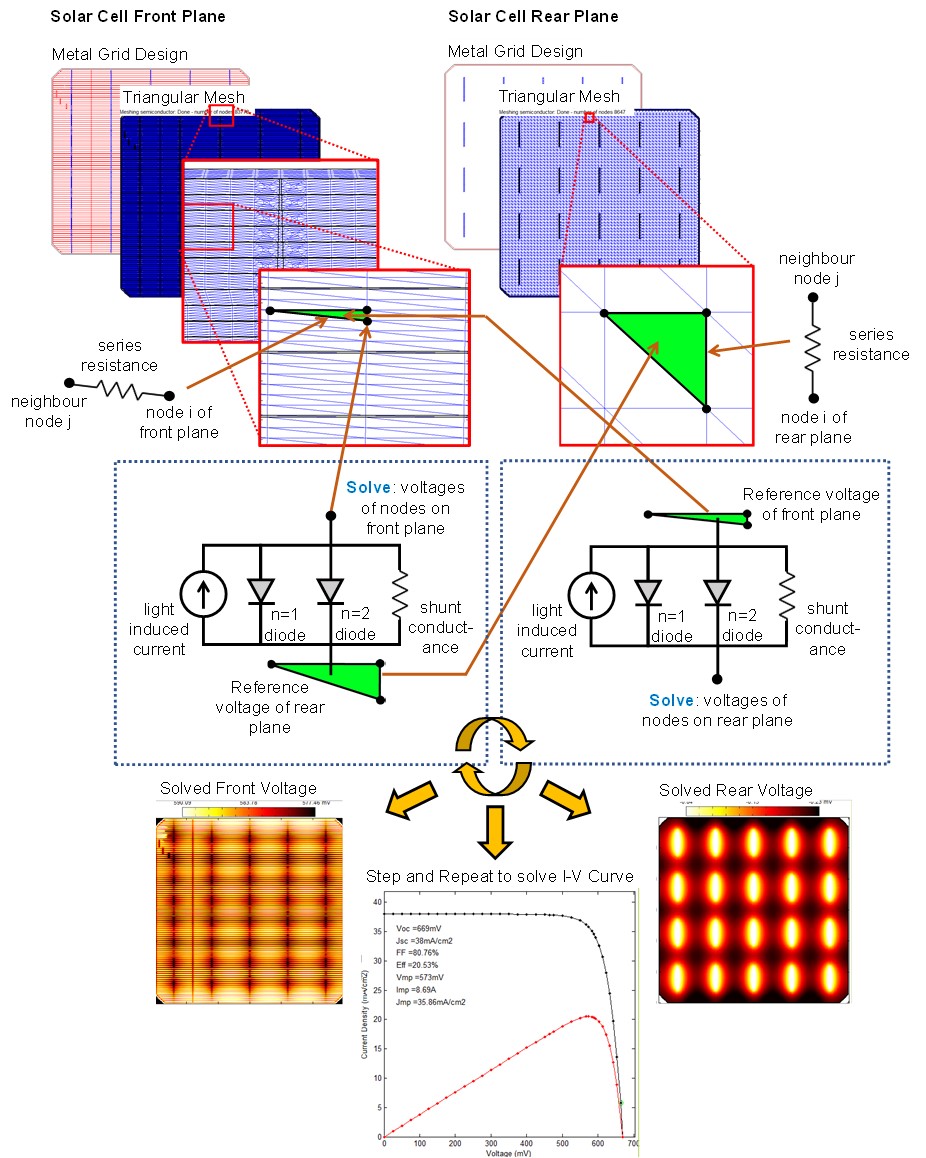Two Diode Network Model of a Solar Cell | 太阳能电池平面的有限元模型

The core of Griddler is a finite element model (FEM) representation of the solar cell planes as shown above. Generally there can be 1 to 8 planes: simplest case being 1 plane to describe a simple grid on the front side, while the rear side is assumed to be perfectly laterally conductive and at ground potential; most complex case is that for each of the front and rear sides there are separately the semiconductor plane, metal finger plane (if there is contact resistance between the fingers and semiconductor), metal busbar plane (if the user chooses dual print to make the busbars “floating”), and ribbons plane (if the user chooses “Solder ribbons at probe points” under the Current Extraction option). In the FEM representation, these planes (except the ribbons planes) are finely broken down into triangular meshes to implement the network model of the solar cell. The above picture shows a triangle element on each of the meshed front and rear semiconductor planes in green. The corners of the triangles are called nodes and each node has a voltage. The edges of the triangles connect the nodes together via resistors whose values depend on the sheet resistance of the region (e.g. relatively high values for semiconductor, low values for metal fingers and busbars), as well as the triangle shape according to the Galerkin method.
Between the front and rear semiconductor planes is a sandwich layer where the photovoltaic properties of the solar cell are implemented. This sandwich layer provides a small equivalent circuit that connects to each node of the semiconductor layers, as shown inside the dotted blue boxes above. The equivalent circuit is also called the two diode model, because it is defined by two diodes of different I-V characteristics in describing the recombination currents happening inside the node. An additional current source is in parallel to these diodes to describe the light-induced current, and a parallel shunt conductance is used to describe shunt currents if any. The I-V characteristics of the equivalent circuit is:
Griddler的核心是如上所示的对太阳能电池平面的有限元模型(FEM)表示。通常可以有1到8个平面:最简单的情况是用1个平面来描述正面电极的金属栅线,假定背面接地,并没有横向电阻;最复杂的情况是,正面和背面分别有半导体平面、金属栅线平面(如果栅线和半导体之间存在接触电阻)、金属主栅平面(如果用户使用分次印刷, 非烧穿主栅, 使主栅“悬浮”)和焊带平面(如果用户在Current Extraction选项下选择“Solder ribbons at probe points”)。在有限元模型中,这些平面(除了焊带平面)被精细地分解成三角形网格,以实现太阳能电池的网络化模型。上图中的绿色三角显示了在网格化之后,电池正面和背面半导体平面中的一个三角形元素。三角形的一个角被称为一个节点(node),每个节点都有一个电压。三角形的边缘(edge)通过电阻将节点连接在一起,电阻的值取决于该区域的薄层电阻(例如,半导体的值会相对较高,金属栅线和主栅的值会相对较低);并且基于伽辽金法,电阻的值也取决于三角形的形状。
在正面和背面半导体平面之间是一个夹层,这个夹层定义了太阳能电池的光伏特性。这种夹层结构提供了一个小的等效电路,连接到半导体层的每个节点,如上图蓝色虚线框内所示。这个等效电路也称为双二极管模型,因为它用两个具有不同I-V特性的二极管来描述节点内发生的复合电流。与这些二极管并联的电流源用以描述光感应电流,并联的分流电导用于描述分流电流(如果有的话)。这个等效电路的I-V特性是:

Where Vdiode,i is the voltage across the equivalent circuit, q is the elementary charge, k is the Boltzmann constant, T is the cell temperature in Kelvin. IL,i is the light induced current, I01,i and I02,i are the saturation currents of the n=1 and n=2 diodes, and Gshunt,i is the shunt conductance. Vdiode,i is given by Vnode,i – Vref,i, where Vnode,i is the voltage of the node i of concern, and Vref,i is an interpolated value of the voltage on the opposite semiconductor plane at the position of the node i. With this, we can formulate the current continuity condition at node i using Kirchhoff's node law:
其中Vdiode,i 是等效电路上的电压,q是基本电荷,k是玻尔兹曼常数,t是电池温度,以开尔文为单位。IL,i 是光感应电流,I01,i 和I02,i 是n=1和n=2二极管的饱和电流,Gshunt,i 是分流电导。Vdiode,i 由Vnode,i – Vref,i,给出的,其中Vnode,i 是对应节点i的电压,Vref,i 是在节点位置相对的半导体平面上的电压的内插值。由此,我们可以利用基尔霍夫节点定律得出在节点i的电流连续性条件:

This allows a system of equations to be constructed for the voltages of the nodes to be solved iteratively. Once the semiconductor node voltages are solved on each plane, Vdiode,i and I(Vdiode,i) are also simultaneously determined. The overall current of the solar cell is then simply the sum of I(Vdiode,i) across all nodes on either the front or rear semiconductor planes, and the overall voltage of the solar cell is then the difference between the front node voltage where current is extracted, and the rear node voltage where current is extracted.
The operating point of the solar cell is defined by the level of illumination, as given by IL,i, and the terminal voltage which sets the boundary condition of the front nodes where current is extracted. The rear node voltage where current is extracted is usually set to zero (ground). By a step and repeat process where the terminal voltage is varied and then the cell voltage is solved, one forms the overall I-V characteristics of the solar cell.
由此我们可以建立一组系统的节点电压的方程组,并进行迭代求解。一旦半导体节点电压在每个平面上被求解,Vdiode,i 和I(Vdiode,i) 也可以被同时确定。然后,太阳能电池的总电流则是在正面或背面半导体平面上所有节点上I(Vdiode,i) 的总和,而太阳能电池的总电压则是提取电流的节点处,正面节点和背面节点电压之间的差值。
太阳能电池的操作点由光照强度IL,i,和终端电压定义。该终端电压定义了提取电流处的正面节点的边界条件。提取电流处的背面节点的电压通常被设置为零(接地)。通过不断设置终端电压并不断重复这一过程,然后解电池电压,我们就可以得到太阳能电池的整体I-V特性。
